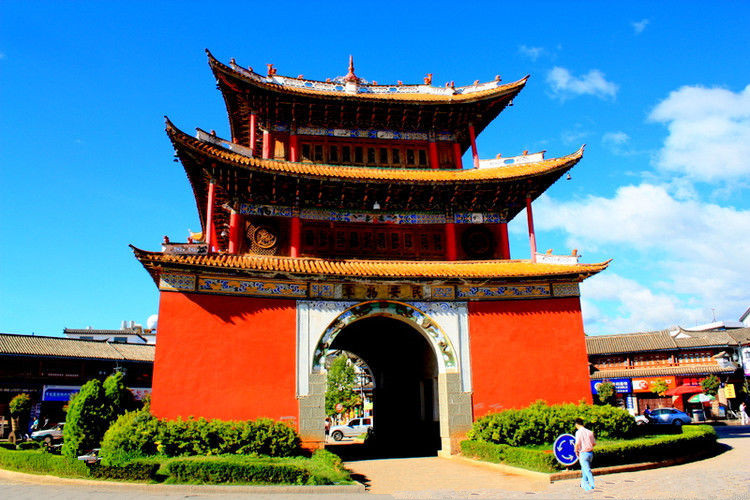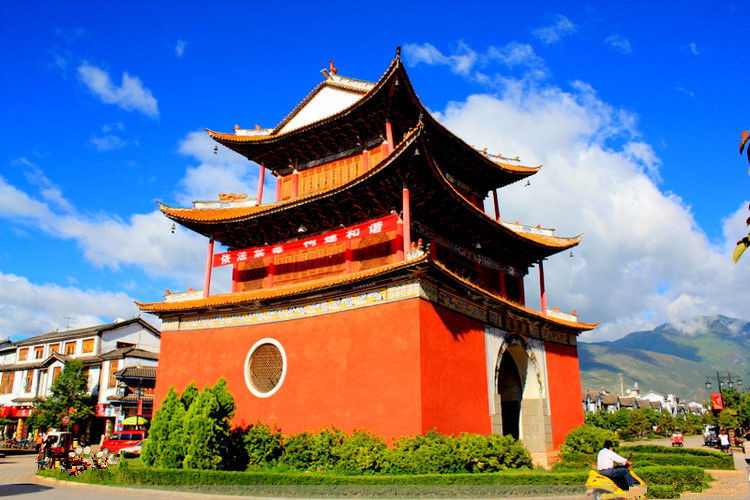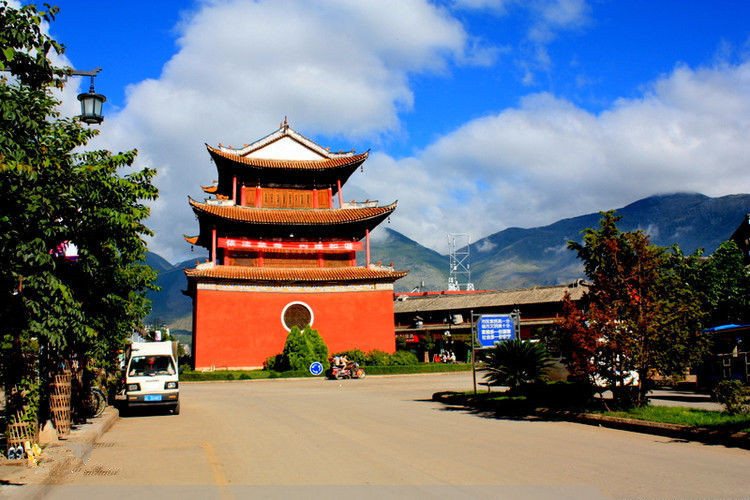
Yunhe Tower in Heqing County, Dali
Yunhe Tower (云鹤楼), located at the center of Heqing County (鹤庆县) in Dali Bai Autonomous Prefecture (大理白族自治州), Yunnan Province (云南省), is a historic and architecturally unique ancient structure. Originally named Anfeng Tower (安丰楼), it was first built in the 9th year of the Zhengde reign (1514) during the Ming Dynasty by official Sun Wei (孙伟) as a paifang-style gateway in front of the government office.
Throughout the centuries, Yunhe Tower has undergone multiple destructions and reconstructions. In 1711 (50th year of Kangxi reign, Qing Dynasty), Tongpan official Tong Zhen (佟镇) led a reconstruction and installed a bell and drum, leading to its common name as the Bell and Drum Tower. It was rebuilt again in 1835 (15th year of Daoguang reign) and in 1901 (27th year of Guangxu reign), after military official Ding Huai (丁槐), serving elsewhere, funded another reconstruction. It was then renamed “Yunhe Tower” (云鹤楼), meaning “White Crane in the Clouds,” symbolizing auspiciousness and peace.

In 1951, a strong earthquake struck Heqing, causing the tower to shift 0.5 meters eastward, rendering it structurally unsafe. In recent years, government funding has enabled restoration efforts, including reinforcing the structure, retiling the roof with glazed tiles, repainting the interior and exterior, and repairing damaged sections—revitalizing this historic monument.
Architectural Features
Yunhe Tower is a classic example of wooden pavilion-style architecture. It stands 19.4 meters tall, 18.6 meters long (east to west), and 14 meters wide (north to south), with a 16-meter-long arched passage underneath. Constructed using traditional mortise-and-tenon joinery, it contains no metal nails, showcasing masterful craftsmanship.
The tower features three external tiers of eaves, though internally it has four stories. Massive corner beams and columns run straight to the roof, with a complex interlocking dougong (斗拱) system, demonstrating structural precision and balance.
The roof is covered in glazed tiles. The two gates are painted with images of twin dragons chasing a pearl and white cranes spreading their wings. On both sides hang a famous long couplet written by late Qing scholar Yang Jinhe (杨金和) and penned by modern writer Xuan Baichao (宣白超). The couplet not only enhances the tower’s aesthetic appeal but also encapsulates Heqing’s rich historical legends and scenic beauty.
Cultural Value

Yunhe Tower is not only a prominent landmark in Heqing (鹤庆) but also one of the first group of key cultural heritage sites protected by Dali Prefecture (大理州). It reflects profound historical and architectural value, bearing witness to the evolution of Heqing from the Ming Dynasty to modern times.
Inside the tower, there were once statues of the Jade Emperor (玉皇大帝) and the “Three Stars” (三星), along with a bell and drum, serving as spiritual symbols for the local people.
The name “Yunhe” also ties into local legend. Heqing’s basin was once a highland lake where white cranes frequently gathered. In the Bai language, Heqing is called “Aokai” (熬凯), meaning “two cranes.” According to legend, when the Dali Kingdom established an administrative center here, flocks of white cranes descended to celebrate, prompting the name “Heqing” (鹤庆, meaning “Crane Celebration”). Thus, “Yunhe Tower” draws directly from this beautiful origin story.
Tourist Information
Yunhe Tower is centrally located in Heqing County (鹤庆县), with convenient access. Heqing has a railway station and a long-distance bus station and is near Lijiang Airport and Dali Airport. The Dali–Lijiang Highway (大丽公路) runs through the region, forming a well-developed transportation network. Visitors can easily travel to Heqing to explore the charm of this ancient tower.
In addition to Yunhe Tower, Heqing County offers many other attractions worth visiting, including Xinhua Bai Ethnic Tourist Village (新华白族旅游村), Caohai Wetland (草海湿地), Wildman Valley (野人谷), Heilongtan (黑龙潭), and Shibao Mountain (石宝山). Together, these destinations enrich Heqing’s tourism resources.
Yunhe Tower is not just a local landmark of Heqing County (鹤庆县) but a cultural icon of Dali Prefecture (大理白族自治州) and Yunnan Province (云南省). It has witnessed the county’s historical evolution and carries the collective memory and emotional ties of its people. Today, thanks to preservation and restoration, Yunhe Tower still stands tall in the center of Heqing, showcasing its grandeur and elegance. Whether you’re an architecture enthusiast or a history lover, Yunhe Tower is a destination worth visiting.

 7 Days GolfingTour
7 Days GolfingTour
 8 Days Group Tour
8 Days Group Tour
 8 Days Yunnan Tour
8 Days Yunnan Tour
 7 Days Shangri La Hiking
7 Days Shangri La Hiking
 11 Days Yunnan Tour
11 Days Yunnan Tour
 6 Days Yuanyang Terraces
6 Days Yuanyang Terraces
 11 Days Yunnan Tour
11 Days Yunnan Tour
 8 Days South Yunnan
8 Days South Yunnan
 7 Days Tea Tour
7 Days Tea Tour
 8 Days Muslim Tour
8 Days Muslim Tour
 12 Days Self-Driving
12 Days Self-Driving
 4 Days Haba Climbing
4 Days Haba Climbing
 Tiger Leaping Gorge
Tiger Leaping Gorge
 Stone Forest
Stone Forest
 Yunnan-Tibet
Yunnan-Tibet
 Hani Rice Terraces
Hani Rice Terraces
 Kunming
Kunming
 Lijiang
Lijiang
 Shangri-la
Shangri-la
 Dali
Dali
 XishuangBanna
XishuangBanna
 Honghe
Honghe
 Kunming
Kunming
 Lijiang
Lijiang
 Shangri-la
Shangri-la
 Yuanyang Rice Terraces
Yuanyang Rice Terraces
 Nujiang
Nujiang
 XishuangBanna
XishuangBanna
 Spring City Golf
Spring City Golf
 Snow Mountain Golf
Snow Mountain Golf
 Stone Mountain Golf
Stone Mountain Golf















